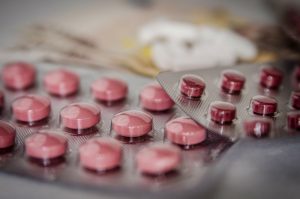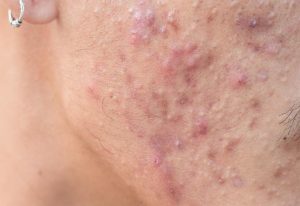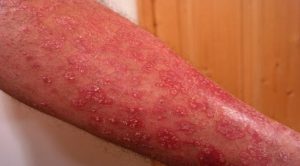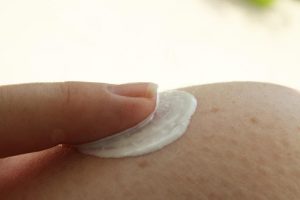
The majority of skin ailments do not require mediation prescribed by a doctor or dermatologist. The most common treatments for skin conditions are over-the-counter, topical treatments. However, there are some types of skin ailments, including chronic or acute conditions which require prescription medications. The following guide lists some common skin problems which may require prescribed medication followed by medications that are commonly used. These are grouped into the following categories; antibiotics, antifungals, corticosteroids, retinoids, immune response modifiers, and other types of skin medications. It includes important information on the drug such as brand names, active ingredients, administration routes, dosage guidelines, and side effects. The guide has been organized in this way because many of the drugs used for skin problems can be used for several ailments. Unless specified all information relates to adults.
Common Skin Ailments that May Require Prescription Medications
Eczema and Dermatitis
Eczema and dermatitis affect people of any age and has a range of symptoms including redness, swelling, scaling, rough, dry, and flaky patches or weeping, oozing sores. Symptoms can be alleviated through avoiding triggers where possible but depending on the severity of symptoms doctors may prescribe emollients or corticosteroids.

Acne
Although commonly affecting teenagers Acne can occur in any age group. It is characterized by spots usually on the face, neck, back, and chest, but can develop anywhere on the body. The severity of the spots or pimples varies enormously from blackheads, pimples, and whiteheads to a more serious and painful condition causing nodules, swelling, pustules, cysts, and redness. Over-the-counter treatments, improved skincare regimes, and lifestyle changes are recommended for mild to moderate acne. However, for more severe symptoms doctors and dermatologists often prescribe corticosteroids or retinoids or a combination of both.
Ringworm, Tineas Pedis/Athletes Foot and Other Fungal Infections
Ringworm is not actually a worm but a common contagious fungal infection and therefore requires treatment with a prescribed antifungal medication. Tinea Pedis/Athlete’s foot can be a chronic issue and may require longer-term treatment or even lifelong management. Although over-the-counter medications are available doctors or dermatologists will be able to prescribe stronger treatments for persistent or acute cases.
Impetigo
A common (especially in children) and highly contagious bacterial skin infection that will go away on its own over a few weeks. However, it can be uncomfortable and unpleasant and patients must remain isolated to halt the spread of infection. Treatment from a doctor will prevent transmission after around 48 hours and clear the infection completely within about a week.
Cellulitis
Though more common in older patients, this bacterial infection can affect people of any age. Symptoms are reddening of the skin and swelling, pain, and fever. It can lead to serious complications and requires prompt prescribed antibiotic treatment.
Rosacea
More common in people over the age of 35 and causes reddening of the central facial area, sometimes with pustules/whiteheads. Treatment for Rosacea includes antibiotics and/or retinoids.

Psoriasis
Characterized by red or silvery patches of rough, scaly skin that can appear anywhere but is most commonly found on the elbows, knees, and scalp. Psoriasis is caused by an overproduction of skills cells possibly related to autoimmune disorders. Prescribed treatments include coal tar products and derivatives.
A more comprehensive list of skin ailments can be found in the article Common Skin Disorders at Every Life Stage: Causes, Prevention and Treatment.
Medications for Skin Problems
Common Antibiotics for Skin Infections
- Clindamycin – this antibiotic medication is used for bacterial skin infections including cellulitis and acne vulgaris. For acne, it is applied topically twice a day. Brand names for this cream include Zindaclin which is a gel and Dalacin T which is a lotion or solution. Both contain around 1% clindamycin. For severe skin infections such as cellulitis, it can be taken orally or, more unusually delivered by intravenous injection or infusion. Doses range from 150-300mg twice daily or in severe cases up to 450mg. When used topically side effects can include skin reactions. In oral use, common side effects include abdominal pain, nausea and diarrhea, and antibiotic-associated colitis – which can be serious.
- Erythromycin – an antibiotic within the group macrolides and is used for a variety of skin problems including acne, rosacea, impetigo, leg ulcers (particularly in diabetic patients), and cellulitis. Although the usual administration route is oral it is also used topically, particularly in conjunction with zinc acetate or tretinoin for acne and acne vulgaris. The usual dosage for oral administration is 250-500mg 4 times daily for up to 7 days. Caution should be used for patients with a history of cardiac problems as it can lead to an increased risk of cardiac events. This antibiotic also is contraindicative with the drug rivaroxaban and can lead to bleeding. Common side effects include gastrointestinal problems including pain and diarrhea, insomnia, skin reactions, headache, and hearing, taste, and vision impairments.
Common Corticosteroid Medications for Skin Ailments

- Hydrocortisone – this is a corticosteroid medication and is used on its own for mild to moderate inflammatory skin disorders such as nappy rash in infants and eczema and dermatitis and oral and perioral (around the mouth) lesions, sores, and dermatitis. It is commonly used topically in creams or lotions at a potency of 0.5 to 2.5%. Side effects, for all corticosteroids, can commonly include mood and behavioral changes, anxiety, insomnia, gastrointestinal discomfort, weight gain, skin disorders, fatigue, and increased susceptibility to infections.
- Alclometasone Dipropionate – this is a low to medium strength topical corticosteroid medication that is commonly prescribed for a variety of inflammatory skin conditions such as allergic reactions, eczema, and dermatitis. It is supplied as a cream that has a low potency of 0.05% and should be applied no more than twice daily. It is not for use on diaper/nappy rash and is not for use on sensitive areas or mucus membranes. Common side effects include skin reactions including telangiectasia or spider veins. Rare side effects, as with all corticosteroids, can be serious and include adrenal suppression, hypertrichosis (excessive hair growth), or loss of pigmentation.
- Hydrocortisone Butyrate- this corticosteroid is used for more acute cases of eczema, dermatitis, and psoriasis or those that have not responded to lower strength steroid-based treatments. It is available in a topical liquid, ointment, or cream with a potency of 0.1%. It should be applied in a thin layer to affected areas once or twice daily. As with all corticosteroids, care must be taken to avoid the eye area and must be washed off the hand thoroughly following application. Side effects can include skin reactions including spider veins and rarely cause adrenal problems.
Commonly Prescribed Antifungal Medications for Fungal Skin Infections
- Econazole Nitrate – a topical antifungal medication that also contains a steroid. Commonly used to treat tinea pedis, more commonly known as athlete’s foot, and fungal nail infections. An often-used brand is Pevaryl and this contains 1% of the active ingredient. A common side effect is skin irritation. If it is severe then use should be discontinued.
- Griseofulvin – this is an antifungal medication used for dermatophyte or fungal skin infections particularly tinea pedis (athlete’s foot). Topical application is most common and will often be administered via a spray which will be between 400 micrograms to 1.2 mg in potency. For fungal infections where topical application is either not possible or when it has not been effective then it can be taken orally. The oral dosage of griseofulvin is between 500mg to 1g daily (which can be split into a morning and evening dose if preferred). Side effects from topical use include skin irritation and paraesthesia (numbness, tickling, skin-crawling sensation). Side effects from oral use include epigastric discomfort, nausea, headache, and vomiting. Less common side effects from oral use include toxic epidermal necrolysis (severe peeling and blistering of the skin), confusion, insomnia, irritability, and dizziness.
Retinoid Medications for Skin Disorders
- Isotretinoin – this retinoid medication is used for severe acne which is resistant to more common approaches to acne management. Severe acne is characterized by deep abscesses (conglobate acne) and/or large, painful lumps (nodular acne). Both these types of acne can cause permanent scarring. It is an isomer, that is a differently structured (atomically speaking) tretinoin which is a more commonly used retinoid medication. Taken orally in doses of 500 micrograms/kg daily with an increase up to 1mg/kg if required. This medication should be taken for 16-24 weeks. However, for women of childbearing age, they must use effective contraception and are required to have a pregnancy test before each monthly prescription is issued. This is due to the likelihood of miscarriage and/or potentially fatal birth defects including physical deformities and severe cognitive impairments. Other side effects of this medication can include altered mood including suicidal tendencies – therefore before prescribing a mental health assessment is usually advised. Less severe but common side effects include headaches, myalgia, hemorrhage (from thrombocytopenia), back pain, anemia, eye problems, skin reactions and fragility, and proteinuria (protein in the urine – which can lead to kidney disease).
- Adapalene – this is a topical retinoid medication for mild to moderate acne in adults and older children (aged 12-17) and can sometimes be purchased without a prescription (US). It is used daily over a period of at least 12 weeks to see the best results. A thin layer of adapalene cream should be applied in the evening – this is to avoid sun exposure immediately following use. As with all topical retinoids, exposure to UV light should be avoided for the duration of the course. Cover skin where possible or wear factor 50+ sunscreen if sunlight cannot be avoided. Although, adapalene does not have a high level of systematic absorption use during pregnancy should be avoided. Side effects include redness, peeling, sunburn, skin irritation and discomfort, itching, and dryness.
- Tretinoin – a topical retinoid for treating acne. As with all retinoid-based creams or gels, this means it is a form of vitamin A, it can cause photosensitivity and must not be used by pregnant women or women who are of child-bearing age and are not using a reliable form (or 2 forms) or contraception. These types of medications promote and speed up skin renewal as well as being anti-inflammatory and may also help to regulate sebum production. Creams, gels, or ointments start at 0.025% potency but this potency can be increased once the skin becomes accustomed to the treatment. It is used nightly and applied in a thin layer to affected areas. Sensitive areas, mucous membranes, and wounds must be avoided as should other products such as moisturizers or makeup. Side effects can include a variety of skin complaints such as redness, dry skin, itching, burning, and peeling. As with all medications if you experience serious side effects consult a medical professional immediately.
Immune Response Modifiers
- Imiquimod – is an immune response modifier that is used for treating basal cell carcinoma (BCC); the most common form of skin cancer. This drug is also used for less serious skin problems such as genital and perianal warts and actinic keratosis. The latter can sometimes turn into skin cancer. Imiquimod commonly goes by two brand names, one is Zyclara which is a cream for treating actinic keratosis to be applied once daily and washed off after 8 hours. The other is Aldara. When using this to treat BCC it is applied to the lesion and a 1cm area surrounding it for 5 nights out of 7 and continued for 6 weeks. Following treatment, assessment should take place 12 weeks after treatment. For genital and perianal warts Aldara is applied for 3 nights out of 7 until symptoms improve and for no more than 16 weeks. For actinic keratosis, it should be applied 3 out of 7 nights over 4 weeks. If necessary this can be repeated once after a break of 4 weeks. Due to the nature of the medication, it is not recommended for people with autoimmune diseases. Common side effects include headaches, nausea, lethargy, weakness, pain, and increased susceptibility to infections.
- Ingenol Mebutate – is another immune response modifier that was commonly prescribed for actinic keratosis. However, due to increased instances of skin tumors both benign and malignant, it is no longer recommended or prescribed in the EU or the UK. The brand Picato no longer makes this medication. People who have used ingenol mebulate should be extra vigilant with regards to any changes in their skin and speak to a doctor or dermatologist if they have any concerns.
Other Types of Medications Used for Skin Problems
- Aciclovir – this is an anti-viral medication that can be administered topically, orally, via eye drops, or in some cases intravenously. Usually prescribed for the herpes simplex virus (cold sore and genital herpes), varicella-zoster (chickenpox), and herpes zoster (shingles) viruses. This drug is also sometimes used as a preventative measure for immunocompromised patients. It is also available over-the-counter cold sore remedy and is usually sold under the brand name Zovirax. Common dosage is for topical use 5x daily. For oral administration, for children with chickenpox, it is often given as a flavored liquid. The dosage can be 200mg 5 times daily or 400mg 3 times daily or, for chickenpox, can be up to 800mg 5x daily. However, the dosage will depend on the patient’s age, type of virus, and other factors so a doctor’s advice should always be followed. Side effects depend on the administrative route and can include: eye pain and inflammable (when eye drops used), skin reactions including photosensitivity, dizziness, headaches, nausea, vomiting, fatigue, and fever – often similar to the symptoms of the virus itself.
- Dithranol – this is a derivative of anthracene which is a hydrocarbon found in coal tar. It is used as a topical treatment for subacute and chronic psoriasis. It is applied as a cream to the affected areas in a cream, shampoo, or ointment with a potency of 0.1% initially and increasing to 0.5% according to tolerance levels. Directions usually stipulate that it should be applied around half an hour before showering or bathing and that soap-free cleansers should be used where possible. Treatment should be continued for around 6 to 12 weeks. Side effects include skin irritation and patients should be aware that it can also cause staining – this makes the shampoo unsuitable for those with blonde or fair hair.
- Emollients – this is a group of medications that has moisturizing properties. Although moisturizers can be bought on the shelf or over the counter there are some which can also be prescribed due to the active ingredients. Several types of emollients contain other ingredients such as anti-microbial (where skin infection is likely), colloidal (oatmeal which has anti-inflammatory properties), urea (naturally present in skin, helps to soften hard skin for better absorption), or paraffin (which creates a barrier protecting the skin).
Please note that this article is for information only and is not a substitute for expert advice. Always consult a doctor or dermatologist for health advice and treatment.
References:
https://bnf.nice.org.uk/drug
https://dermnetnz.org
https://knowyourskin.britishskinfoundation.org.uk/
https://medlineplus.gov/druginformation.html
https://www.bad.org.uk/shared/get-file.ashx?id=2314&itemtype=document
https://www.mayoclinic.org/diseases-conditions/acne/diagnosis-treatment/drc-20368048
https://www.niams.nih.gov/health-topics/skin-diseases
https://www.skincancer.org/skin-cancer-information/basal-cell-carcinoma/bcc-treatment-options/
Nguyen T, Zuniga R. Skin conditions: new drugs for managing skin disorders. FP Essent. 2013 Apr;407:11-6. PMID: 23600334.



